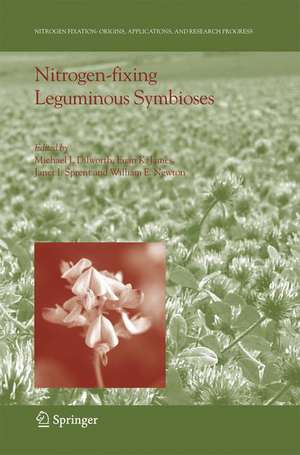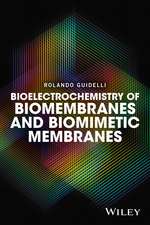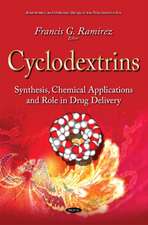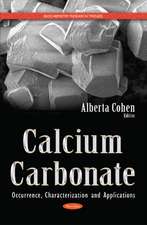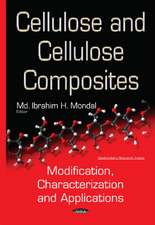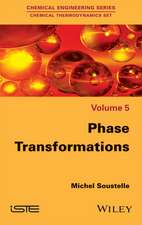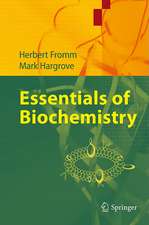Nitrogen-fixing Leguminous Symbioses: Nitrogen Fixation: Origins, Applications, and Research Progress, cartea 7
Editat de Michael J. Dilworth, Euan K. James, Janet I. Sprent, William E. Newtonen Limba Engleză Hardback – 30 ian 2008
| Toate formatele și edițiile | Preț | Express |
|---|---|---|
| Paperback (1) | 1217.41 lei 6-8 săpt. | |
| SPRINGER NETHERLANDS – 18 noi 2010 | 1217.41 lei 6-8 săpt. | |
| Hardback (1) | 1230.66 lei 6-8 săpt. | |
| SPRINGER NETHERLANDS – 30 ian 2008 | 1230.66 lei 6-8 săpt. |
Preț: 1230.66 lei
Preț vechi: 1500.81 lei
-18% Nou
Puncte Express: 1846
Preț estimativ în valută:
235.48€ • 245.86$ • 194.89£
235.48€ • 245.86$ • 194.89£
Carte tipărită la comandă
Livrare economică 04-18 aprilie
Preluare comenzi: 021 569.72.76
Specificații
ISBN-13: 9781402035456
ISBN-10: 1402035454
Pagini: 402
Ilustrații: XIX, 403 p.
Dimensiuni: 155 x 235 x 23 mm
Greutate: 0.82 kg
Ediția:2008
Editura: SPRINGER NETHERLANDS
Colecția Springer
Seria Nitrogen Fixation: Origins, Applications, and Research Progress
Locul publicării:Dordrecht, Netherlands
ISBN-10: 1402035454
Pagini: 402
Ilustrații: XIX, 403 p.
Dimensiuni: 155 x 235 x 23 mm
Greutate: 0.82 kg
Ediția:2008
Editura: SPRINGER NETHERLANDS
Colecția Springer
Seria Nitrogen Fixation: Origins, Applications, and Research Progress
Locul publicării:Dordrecht, Netherlands
Public țintă
ResearchCuprins
Preface to the Series, Preface, List of Contributors, Dedication
1. Evolution and Diversity of Legume Symbiosis: J. I. Sprent
1. Introduction
2. The Diversity of Legume Nodules
3. The First 700 Million Years
4. The Last 60 Million Years
5. The Present
6. Conclusions
References
2. Ecology of Root-nodule Bacteria of Legumes: P. H. Graham
1. Introduction
2. Taxonomy of Root-nodule Bacteria
3. Population Structure of Rhizobia in Soil and Rhizosphere
4. Above and Below Ground Diversity and Symbiotic Function
5. Strain Competitiveness, Rhizosphere Colonization, and Persistence
6. Edaphic Factors Affecting Rhizobia
7. Future Dimensions of Rhizobial Ecology
References
3. Maintaining Cooperation in the Legume-Rhizobia Symbiosis: Identifying Selection Pressures and Mechanisms: E. T. Kiers, S. A. West and R. F. Denison
1. Introduction
2. Explaining Cooperation: The Problem
3. Explaining Cooperation: The Hypothesis
4. Cheating and Mixed Nodules
5. Future Directions
6. Conclusions
Acknowledgements
References
4. Inoculation Technology for Legumes: D. F. Herridge
1. Introduction
2. The Need to Inoculate
3. Selection of Rhizobial Strains for Use in Inoculants
4. Inoculants in the Market Place
5. Pre-inoculated and Custom-inoculated Seed
6. Co-inoculation of Legumes with Rhizobia and Other Beneficial Microorganisms
7. Quality Control of Legume Inoculants
8. Constraints to Inoculant Use and Future Prospects
9. Concluding Statements
References
5. Fine-tuning of Symbiotic Genes in Rhizobia: Flavonoid Signal Transduction Cascade: H. Kobayashi and W. J. Broughton
1. Introduction
2. NODD and NOD-boxes: Central Elements in Transduction of Flanovoid Signals
3. Functions of Genes Controlled by NOD-boxes4. Fine-tuning Expression of Symbiotic Genes in Restricted Host-Range Rhizobia
5. Post-genomic Studies: Do Flavonoids Regulate Other Genes?
6. Conclusion and Perspectives: Roles of Flavonoid-inducible Regulons in Symbiosis, Signaling, and Adaptation
References
6. Cell Biology of Nodule Infection and Development: N. Maunoury, A. Kondorosi, E. Kondorosi and P. Mergaert
1. Introduction
2. Nod-factor Signalling
3. Cortical-cell Activation Leading to Primordium Formation and Infection
4. Secondary Signals for Nod Factor-induced Cell Activation
5. Differentiation of N2-fixing Cells: The Role of Endoreduplication
6. Bacteroid Differentiation
7. Nitrogen Fixation
8. Senescence of Nodules
References
7. Genetics, A Way to Unravel Molecular Mechanisms Controlling the Rhizobial-Legume Symbiosis: P. Smit and T. Bisseling
1. Introduction
2. Model Legumes
3. Genetic Dissection of the Nod Factor-Signalling Pathway
4. Nature of the Nod-factor Receptors
5. The DMI Proteins
6. NSPs are Nod Factor-Response Factors
7. NIN is a Nod Factor-Response Factor
8. Autoregulation of Nodule Number
9. Concluding Remarks
References
8. Legume Genomics Relevant to N2 Fixation: L. Schauser, M. Udvardi, S. Tabata and J. Stougaard
1. Introduction
2. Genomes
3. Transcriptome Analysis
4. Proteomic
5. Metabolomics
6. Genetic Analysis Using Genomics
7. Comparative Genomics
8. Conclusions
References
9. Physiology of Root-nodule Bacteria: P. S. Poole, M. F. Hynes, A. W. B. Johnston, R. P. Tiwari, W. G. Reeve and J. A. Downie
1. Introduction
2. Introduction to Central Metabolism
3. Metabolism and the Environment
4. Micronutrition, Metals, and Vitamins
5. Environmental Responses of Rhizobia
6. Changes in Gene Expression in Bacteroids
7.Stress Responses in Rhizobia
References
10. Carbon and Nitrogen Metabolism in Legume Nodules: C. P. Vance
1. Legume Root Nodules are Carbon and Nitrogen Factories
2. Nodule Carbon Metabolism
3. Sucrose Synthase
4. Phosphoenolpyruvate Carboxylase
5. Carbonic Anhydrase
6. Malate Dehydrogenase
7. Initial Assimilation of Fixed-N
8. Glutamine Synthetase
9. Glutamate Synthase
10. Aspartate Aminotransferase
11. Asparagine Synthetase
12. Ureide Biosynthesis
13. Genomic Insights
14. Overview
References
11. Oxygen Diffusion, Production of Reactive Oxygen and Nitrogen Species, and Antioxidants in Legume Nodules: F. R. Minchin, E. K. James and M. Becana
1. Introduction
2. Physiological Evidence for a Variable Oxygen-diffusion Barrier
3. Structure of the Cortical Oxygen-diffusion Barrier
4. Development of the Cortical Oxygen-diffusion Barrier
5. Regulation of the Cortical Oxygen-diffusion Barrier
6. Infected Zone Control
7. Reactive Oxygen and Nitrogen Species in Nodules
8. Antioxidants in Nodules
9. Concluding Remarks
References
12. Prospects for the Future Use of Legumes: J. G. Howieson, R. J. Yates, K, Foster, D. Real and B. Besier
1. Introduction
2. Current and Past Legume-Usage Patterns
3. New Uses for Legumes
4. Matching Legumes and the Symbiosis to Edaphic and Economic Factors
5. Utilising the Basic Advances
6. Conclusions
References
Subject Index
1. Evolution and Diversity of Legume Symbiosis: J. I. Sprent
1. Introduction
2. The Diversity of Legume Nodules
3. The First 700 Million Years
4. The Last 60 Million Years
5. The Present
6. Conclusions
References
2. Ecology of Root-nodule Bacteria of Legumes: P. H. Graham
1. Introduction
2. Taxonomy of Root-nodule Bacteria
3. Population Structure of Rhizobia in Soil and Rhizosphere
4. Above and Below Ground Diversity and Symbiotic Function
5. Strain Competitiveness, Rhizosphere Colonization, and Persistence
6. Edaphic Factors Affecting Rhizobia
7. Future Dimensions of Rhizobial Ecology
References
3. Maintaining Cooperation in the Legume-Rhizobia Symbiosis: Identifying Selection Pressures and Mechanisms: E. T. Kiers, S. A. West and R. F. Denison
1. Introduction
2. Explaining Cooperation: The Problem
3. Explaining Cooperation: The Hypothesis
4. Cheating and Mixed Nodules
5. Future Directions
6. Conclusions
Acknowledgements
References
4. Inoculation Technology for Legumes: D. F. Herridge
1. Introduction
2. The Need to Inoculate
3. Selection of Rhizobial Strains for Use in Inoculants
4. Inoculants in the Market Place
5. Pre-inoculated and Custom-inoculated Seed
6. Co-inoculation of Legumes with Rhizobia and Other Beneficial Microorganisms
7. Quality Control of Legume Inoculants
8. Constraints to Inoculant Use and Future Prospects
9. Concluding Statements
References
5. Fine-tuning of Symbiotic Genes in Rhizobia: Flavonoid Signal Transduction Cascade: H. Kobayashi and W. J. Broughton
1. Introduction
2. NODD and NOD-boxes: Central Elements in Transduction of Flanovoid Signals
3. Functions of Genes Controlled by NOD-boxes4. Fine-tuning Expression of Symbiotic Genes in Restricted Host-Range Rhizobia
5. Post-genomic Studies: Do Flavonoids Regulate Other Genes?
6. Conclusion and Perspectives: Roles of Flavonoid-inducible Regulons in Symbiosis, Signaling, and Adaptation
References
6. Cell Biology of Nodule Infection and Development: N. Maunoury, A. Kondorosi, E. Kondorosi and P. Mergaert
1. Introduction
2. Nod-factor Signalling
3. Cortical-cell Activation Leading to Primordium Formation and Infection
4. Secondary Signals for Nod Factor-induced Cell Activation
5. Differentiation of N2-fixing Cells: The Role of Endoreduplication
6. Bacteroid Differentiation
7. Nitrogen Fixation
8. Senescence of Nodules
References
7. Genetics, A Way to Unravel Molecular Mechanisms Controlling the Rhizobial-Legume Symbiosis: P. Smit and T. Bisseling
1. Introduction
2. Model Legumes
3. Genetic Dissection of the Nod Factor-Signalling Pathway
4. Nature of the Nod-factor Receptors
5. The DMI Proteins
6. NSPs are Nod Factor-Response Factors
7. NIN is a Nod Factor-Response Factor
8. Autoregulation of Nodule Number
9. Concluding Remarks
References
8. Legume Genomics Relevant to N2 Fixation: L. Schauser, M. Udvardi, S. Tabata and J. Stougaard
1. Introduction
2. Genomes
3. Transcriptome Analysis
4. Proteomic
5. Metabolomics
6. Genetic Analysis Using Genomics
7. Comparative Genomics
8. Conclusions
References
9. Physiology of Root-nodule Bacteria: P. S. Poole, M. F. Hynes, A. W. B. Johnston, R. P. Tiwari, W. G. Reeve and J. A. Downie
1. Introduction
2. Introduction to Central Metabolism
3. Metabolism and the Environment
4. Micronutrition, Metals, and Vitamins
5. Environmental Responses of Rhizobia
6. Changes in Gene Expression in Bacteroids
7.Stress Responses in Rhizobia
References
10. Carbon and Nitrogen Metabolism in Legume Nodules: C. P. Vance
1. Legume Root Nodules are Carbon and Nitrogen Factories
2. Nodule Carbon Metabolism
3. Sucrose Synthase
4. Phosphoenolpyruvate Carboxylase
5. Carbonic Anhydrase
6. Malate Dehydrogenase
7. Initial Assimilation of Fixed-N
8. Glutamine Synthetase
9. Glutamate Synthase
10. Aspartate Aminotransferase
11. Asparagine Synthetase
12. Ureide Biosynthesis
13. Genomic Insights
14. Overview
References
11. Oxygen Diffusion, Production of Reactive Oxygen and Nitrogen Species, and Antioxidants in Legume Nodules: F. R. Minchin, E. K. James and M. Becana
1. Introduction
2. Physiological Evidence for a Variable Oxygen-diffusion Barrier
3. Structure of the Cortical Oxygen-diffusion Barrier
4. Development of the Cortical Oxygen-diffusion Barrier
5. Regulation of the Cortical Oxygen-diffusion Barrier
6. Infected Zone Control
7. Reactive Oxygen and Nitrogen Species in Nodules
8. Antioxidants in Nodules
9. Concluding Remarks
References
12. Prospects for the Future Use of Legumes: J. G. Howieson, R. J. Yates, K, Foster, D. Real and B. Besier
1. Introduction
2. Current and Past Legume-Usage Patterns
3. New Uses for Legumes
4. Matching Legumes and the Symbiosis to Edaphic and Economic Factors
5. Utilising the Basic Advances
6. Conclusions
References
Subject Index
Recenzii
From the reviews:
"This is the final volume in a comprehensive seven volume series on all aspects of nitrogen fixation, one of the key biological processes on the planet and still a major provider of nitrogen in agro-ecosystems. … A wide range of topics is … presented in an easy to read style, with good clear diagrams and figures. … This is a well-written comprehensive text, with extensive bibliographies, that will be useful to students and academics at all levels, and is to be recommended strongly." (Ron Wheatley, Experimental Agriculture, Vol. 45, 2009)
"This is the final volume in a comprehensive seven volume series on all aspects of nitrogen fixation, one of the key biological processes on the planet and still a major provider of nitrogen in agro-ecosystems. … A wide range of topics is … presented in an easy to read style, with good clear diagrams and figures. … This is a well-written comprehensive text, with extensive bibliographies, that will be useful to students and academics at all levels, and is to be recommended strongly." (Ron Wheatley, Experimental Agriculture, Vol. 45, 2009)
Textul de pe ultima copertă
This book is the self-contained final volume of a comprehensive seven-volume series covering the basic and applied science relating to nitrogen fixation. It addresses the most important nitrogen-fixing symbiosis of all – that between legumes and their root-nodule bacteria – and therefore deals with the properties and behaviour of both macro- and micro-symbiont. The coverage is comprehensive, beginning with the extent of the symbiosis and how it may have arisen in the geological past. It considers how legumes select the root-nodule bacteria they allow to form nodules on their roots and the intricate series of signals to be exchanged between legume and bacteria for infection to occur. The immense progress in understanding the genetic systems in the bacteria necessary for nodulation is now being replicated in a rapidly increasing understanding of the required systems in the legumes. The cell biology of the processes of both infection and nodule development is analysed and leads to a parallel assessment of the biochemical processes in carbon and nitrogen metabolism required for successful nitroogen fixation by the symbiotic bacteroid. Attention is given to the ways in which the nodule has solved the conundrum of providing enough O2 for energy generation to drive nitrogen fixation without either inactivating the O2-sensitive nitrogenase or creating damaging reactive oxygen species. This volume also covers the basic physiology of the variety of root-nodule bacteria infecting legumes, as well as looking at the renewed controversy about the chemical form(s) of nitrogen exported to the legume. Successful exploitation of the legume symbiosis in agriculture, horticulture, and forestry demands an understanding of the ecology of the root-nodule bacteria – particularly what makes for a successful inoculant strain for legume introduction to agricultural systems. Then, there is a requirement for inoculation technology to both successfully deliverviable bacteria to the root surface and facilitate nodulation. These practical aspects are thoroughly covered in this volume, with a final chapter assessing how the massive amount of recent information can be exploited in matching host and microsymbiont for the wide variety of environments in which they are needed in our production systems.
Caracteristici
Provides an in-depth and up-to-the minute analysis of what is known about this symbiosis, its origins, the process of nodule formation and development, and the biochemistry and genetics of nodular nitrogen fixation Reviews the physiology of the root-nodule bacteria themselves, their ecology in both natural and agricultural systems, and how we go about introducing new legumes and the bactria they require Also brings together all the knowledge gained about this system which can be applied in the future for better legume-rhizobia functioning in difficult environments
